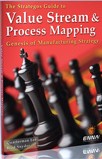Why a Formal Manufacturing Strategy?
In the 1970's, when American manufacturing was being challenged by overseas firms and appeared to be in serious decline, Wickham Skinner made a number of
observations that eventually led to the concept of Manufacturing Strategy." Skinner noticed that, in many cases:
- Manufacturing was focused on cost control while Marketing emphasized other reasons for buying the product such as quality, delivery or
variety.
- Most cost reduction efforts were aimed at Direct Labor which represented a small and decreasing portion of the cost structure.
- Many American factories had become so large and complex they were impossible to manage well.
Optimizing Manufacturing Capability
Every firm wants to optimize their manufacturing. But, optimization requires some criteria. Many companies just assume that the criteria is cost and,
especially, direct labor cost and capital cost. In fact, there are other factors that might be optimized. For example:
- The ability to deliver quickly
- The Ability to deliver reliably
- The ability to produce high quality
- The ability to
build high variety
- The Ability to introduce new products quickly
- The ability to deliver to certain locations
- The ability
to handle volume fluctuations and remain profitable
These various dimensions of manufacturing performance often conflict. For example low cost and high variety often require different types of equipment
and different plant layouts. Moreover, a manufacturing system, like any other engineering design, cannot optimize all dimensions simultaneously. The
question of which dimension is most important constantly shifts in many firms. Near the end of the month, delivery is most important. After the first of the
month, cost labor cost is most important. When an important customer complains, quality is most important.
Wickham Skinner suggests the identification of a "Key Manufacturing Task" that
becomes the unchanging, stabilizing criteria for a variety of decisions, both strategic and tactical. Terry Hill describes
"Order Winning Criteria" as a way of arriving at the Key Manufacturing Task.
Support of Marketing Strategy
Marketing may develop a strategy that manufacturing simply cannot fulfill. Or manufacturing may optimize on the wrong parameters. A factory built for low
labor cost may not be suitable for a marketing strategy that requires the rapid and continual introduction of new products. For an example, see our articles
on Apple, Foxconn & Manufacturing Strategy.
Coordinating With Financial Strategy
The coordination of Marketing, Finance and Manufacturing strategies is critical for long-term competitiveness. This coordination is often lacking.
Marketing may emphasize a Cost Leadership strategy, for example, while finance is unaware that such a strategy may require continual and long-term capital
investment.
Decision Guidance
One of the most important functions of Manufacturing Strategy is the guidance of lower level, shorter-term decisions. For example, should we buy this
automated equipment or take a more manual approach? The automated equipment may bring lower direct labor costs but reduce new product flexibility. The
correct answer depend upon whether Marketing is pursuing a cost leadership strategy or an innovation strategy. The innovation strategy may require many new
product introductions and have far shorter product life cycles.
Systems Thinking
Most manufacturing people visualize their factories as static of steady-state models. Such Mental Models can be quite misleading. Real systems often
exhibit strange behaviors that are unpredictable with steady-state models. Systems Thinking is vital for the leader of any organization, particularly so in
manufacturing. For a really in-depth view of Systems Thinking go to Principia Cybernetica. Our website has a number of pages related to or showing examples of Systems Behavior:
|
Where Does The Strategy Apply?
Almost everywhere. Here is a partial listing of areas that a Manufacturing Strategy might address:
Structure
|
Facilities
|
Non-Physical Infrastructure
|
- Process Linkage (Workflow)
- Process Scale
- Process Flexibility
- Process Technology
-
Capacity Targets
- Supplier Requirements
- Supplier Relations
- Make-Buy Policy
|
- Site Size
- Utility Systems
- Site Location
- Site Focus
- Plant Layout
|
- Accounting System
- Labor Reporting
- Personnel Policies
- Employee Skills, Education & Attitude
- Corporate Culture
- Management Style
- Scheduling Approaches
- Maintenance
- Quality
- Communications
|
When To Develop the Formal Strategy
It is never too early to develop a formal manufacturing strategy. It is sometimes too late if the firm is in the last extremity. In most cases, a firm
has had recurrent difficulties with production, quality, new products or all the above. This situation may actually be essential for creating a sense of
urgency. New leadership, especially when a difficult situation has existed for some time, often initiates the strategic debate.
|





